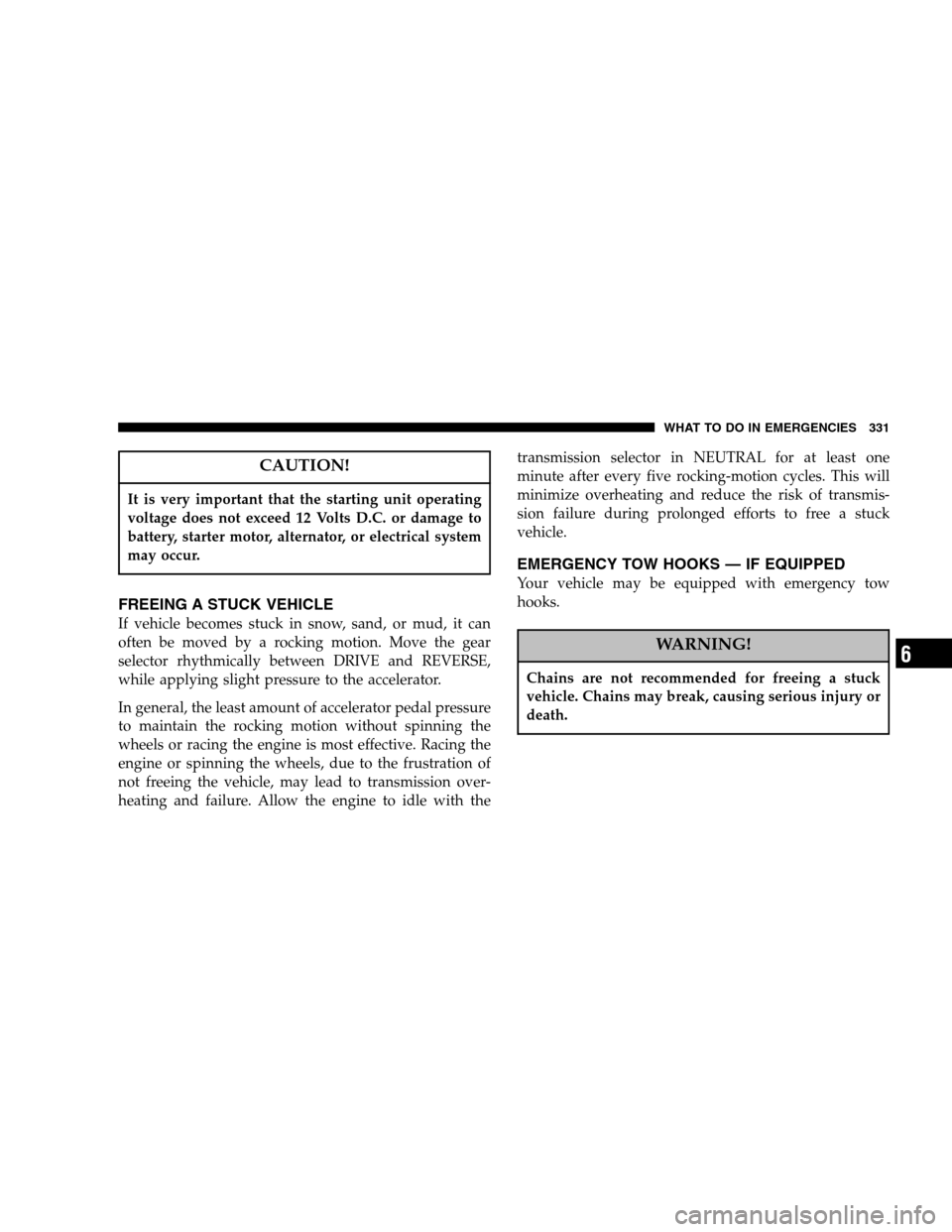Page 328 of 448

Your vehicle is equipped with two 12–volt batteries. If it
becomes necessary to use a booster battery, with jumper
cables, to start a vehicle’s engine because its batteries are
discharged, the following procedure should be followed:
Set the parking brake and place an automatic transmis-
sion in PARK (or NEUTRAL for a manual transmission).
Turn off lights, heater and other electrical loads. Observe
charge indicator (if equipped) in both batteries. If indica-
tor (if equipped) is light or yellow on either battery,
replace that battery.CAUTION!
Use the Jump Start Procedure only when the charge
indicator (if equipped) in both batteries is dark in
the center. Do not attempt jump starting when either
battery charge indicator (if equipped) is bright or
yellow. If charge indicator (if equipped) has a green
dot in the center, failure to start is not due to a
discharged battery and cranking system should be
checked.
1. Attach one jumper cable to the positive terminal of
booster battery and the other end of the same cable to the
positive terminal of the discharged battery.
328 WHAT TO DO IN EMERGENCIES
Page 331 of 448

CAUTION!
It is very important that the starting unit operating
voltage does not exceed 12 Volts D.C. or damage to
battery, starter motor, alternator, or electrical system
may occur.
FREEING A STUCK VEHICLE
If vehicle becomes stuck in snow, sand, or mud, it can
often be moved by a rocking motion. Move the gear
selector rhythmically between DRIVE and REVERSE,
while applying slight pressure to the accelerator.
In general, the least amount of accelerator pedal pressure
to maintain the rocking motion without spinning the
wheels or racing the engine is most effective. Racing the
engine or spinning the wheels, due to the frustration of
not freeing the vehicle, may lead to transmission over-
heating and failure. Allow the engine to idle with thetransmission selector in NEUTRAL for at least one
minute after every five rocking-motion cycles. This will
minimize overheating and reduce the risk of transmis-
sion failure during prolonged efforts to free a stuck
vehicle.
EMERGENCY TOW HOOKS — IF EQUIPPED
Your vehicle may be equipped with emergency tow
hooks.
WARNING!
Chains are not recommended for freeing a stuck
vehicle. Chains may break, causing serious injury or
death.
WHAT TO DO IN EMERGENCIES 331
6
Page 336 of 448

▫Front Axle Universal Drive Joints And Pivot
Bearings............................358
▫Body Lubrication.....................358
▫Windshield Wiper Blades................359
▫Windshield Washers...................359
▫Exhaust System......................360
▫Cooling System.......................361
▫Fan ...............................365
▫Charge Air Cooler (Inter-Cooler)..........365
▫Hoses And Vacuum/Vapor Harnesses.......366
▫Brake System........................366
▫Clutch Linkage.......................368
▫Clutch Hydraulic System................369▫Rear Axle And 4X4 Front Driving Axle Fluid
Level..............................369
▫Transfer Case — If Equipped.............370
▫Manual Transmission — If Equipped.......370
▫Automatic Transmission................370
▫Front Wheel Bearings..................373
▫Selection Of Lubricating Grease...........373
▫Noise Control System Required Maintenance
& Warranty.........................374
▫Appearance Care And Protection From
Corrosion...........................379
�Fuse And Relay Center...................383
�Vehicle Storage........................384
�Replacement Light Bulbs.................384
336 MAINTAINING YOUR VEHICLE
Page 337 of 448
�Bulb Replacement......................385
▫Headlight (Halogen)/Front Park And Turn
Lights.............................385
▫Tail, Stop, Turn And Backup Lights.........389
▫Center High-Mounted Stoplight With Cargo
Light..............................391
▫Cab Top Clearance Lights — If Equipped....393
▫Tailgate ID Lights (Dual Rear Wheels).......394▫Side Marker Lights (Dual Rear Wheels)......396
▫Fog Lights..........................396
�Fluid Capacities........................397
�Recommended Fluids, Lubricants And Genuine
Parts................................398
▫Engine.............................398
▫Chassis............................399
MAINTAINING YOUR VEHICLE 337
7
Page 339 of 448

ONBOARD DIAGNOSTIC SYSTEM (OBD II)
CARB emission control vehicles are equipped with a
sophisticated onboard diagnostic system called OBDII.
This system monitors the performance of the emissions,
engine, and automatic transmission control systems.
When these systems are operating properly, your vehicle
will provide excellent performance and fuel economy, as
well as engine emissions well within current government
regulations.
If any of these systems require service, the OBD II system
will turn on the “Malfunction Indicator Light.” It will
also store diagnostic codes and other information to
assist your service technician in making repairs. Al-
though your vehicle will usually be driveable and not
need towing, see your dealer for service as soon as
possible.CAUTION!
Prolonged driving with the “Malfunction Indicator
Light” on could cause further damage to the emis-
sion control system. It could also affect fuel economy
and driveability. The vehicle must be serviced before
any emissions tests can be performed.
If the “Malfunction Indicator Light” is flashing,
severe catalytic converter damage and power loss
will soon occur. Immediate service is required.
REPLACEMENT PARTS
Use of genuine Mopar�parts for normal/scheduled
maintenance and repairs is highly recommended to in-
sure the designed performance. Damage or failures
caused by the use of non-Mopar parts for maintenance
and repairs will not be covered by the manufacturer’s
warranty.
MAINTAINING YOUR VEHICLE 339
7
Page 347 of 448

CAUTION!
The filtering medium of other aftermarket filters
may disintegrate. Debris from failed filters may plug
the piston oil cooling nozzles, resulting in scuffed
pistons and engine failure.
CAUTION!
Fill the oil filter element with clean oil before
installation. Use the same type oil that will be used
in the engine. When filling the oil filter, prevent
foreign material from falling into the filter. Severe
engine damage may occur.
Apply a light film of lubricating oil to the sealing surface
of the filter gasket before installing the filter.
CAUTION!
Overtightening may distort the threads or damage
the filter element seal.
Install the filter as specified by the filter manufacturer.
Turn the filter 3/4 to one full turn after making contact
with the gasket.
Check the condition of the threads and sealing surface on
the oil pan and drain plug.
Install the drain plug and sealing washer and tighten to
37 ft-lbs. (50 N·m).
Use only high-quality multi-grade lubricating oil in your
Cummins Diesel Engine. Choose the correct oil for your
operating conditions as outlined in the Selection of
Engine Oil.
MAINTAINING YOUR VEHICLE 347
7
Page 354 of 448
Maintenance Free Batteries
The top of the maintenance free batteries are perma-
nently sealed. You will never have to add water, nor is
periodic maintenance required.
To determine the battery charge, check the battery test
indicator (if equipped) on top of each battery. If the test
indicator (if equipped) appears light or yellow, replace
the battery.NOTE:Replacement batteries should both be of equal
capacity to prevent damage to the vehicle’s charging
system.
CAUTION!
It is essential when replacing the cables on the
battery that the positive cable is attached to the
positive post and the negative cable is attached to the
negative post. Battery posts are marked (+) positive
and negative (-) and identified on the battery case.
Also, if a “fast charger” is used while battery is in
vehicle, disconnect both vehicle battery cables be-
fore connecting the charger to battery. Do not use a
“fast charger” to provide starting voltage.
354 MAINTAINING YOUR VEHICLE
Page 373 of 448

NOTE:If the transmission is disassembled for any
reason, the fluid and filter should be changed, and the
bands adjusted (if equipped).
Special Additives
The manufacturer recommends against the addition of
any additives to the transmission. Exception to this
policy is the use of special dyes to aid in detecting fluid
leaks. The use of transmission sealers should be avoided,
since they may adversely affect seals.
Front Wheel Bearings
Front wheel bearings for all Dodge Ram Trucks are
sealed-for-life. They do not require greasing or seal
replacement. In some instances, these bearings will
“purge” excess grease and the bearing housing will look
slightly wet. This is normal.
•Periodic inspection for excess play is recommended.
•If a bearing assembly is accidentally separated when
servicing the brake rotors, it should be replaced.
Rear Wheel Bearings
Clean and repack when brake linings are replaced or
rotors resurfaced.
Selection Of Lubricating Grease
The National Lubricating Grease Institute (NLGI) has
developed a symbol (Certification Mark) to aid the
vehicle owner in the proper selection of grease for the
lubrication of wheel bearings and chassis components.
This symbol (an example shown below) is located on the
grease container and identifies the application and qual-
ity of the grease.
MAINTAINING YOUR VEHICLE 373
7